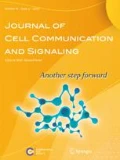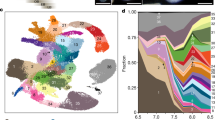Abstract
CCN proteins play crucial roles in development, angiogenesis, cell motility, matrix turnover, proliferation, and other fundamental cell processes. Early embryonic lethality in CCN5 knockout and over-expressing mice led us to characterize CCN5 distribution in early development. Previous papers in this series showed that CCN5 is expressed widely in mice from E9.5 to adult; however, its distribution before E9.5 has not been studied. To fill this gap in our knowledge of CCN5 expression in mammals, RT-PCR was performed on preimplantation murine embryos: 1 cell, 2 cell, 4 cell, early morula, late morula, and blastocyst. CCN5 mRNA was not detected in 1, 2, or 4 cell embryos. It was first detected at the early morula stage and persisted to the preimplantation blastocyst stage. Immunohistochemical staining showed widespread CCN5 expression in post-implantation blastocysts (E4.5), E5.5, E6.5, and E7.5 stage embryos. Consistent with our previous study on E9.5 embryos, this expression was not limited to a particular germ layer or cell type. The widespread distribution of CCN5 in early embryos suggests a crucial role in development.





Similar content being viewed by others
Abbreviations
- CCN:
-
Cysteine-rich 61/Connective Tissue Growth Factor/Nephroblastoma-overexpressed family of Proteins
- E[#]:
-
Embryonic day [number]
- RT-PCR:
-
Reverse transcriptase polymerase chain reaction
- SMC:
-
Smooth muscle cells
References
Ando H, Fukuda N, Kotani M, Yokoyama S, Kunimoto S, Matsumoto K, Saito S, Kanmatsuse K, Mugishima H (2004) Chimeric DNA-RNA hammerhead ribozyme targeting transforming growth factor-beta 1 mRNA inhibits neointima formation in rat carotid artery after balloon injury. Eur J Pharmacol 483:207–14
Cervello M, Giannitrapani L, Labbozzetta M, Notarbartolo M, D’Alessandro N, Lampiasi N, Azzolina A, Montalto G (2004) Expression of WISPs and of their novel alternative variants in human hepatocellular carcinoma cells. Ann N Y Acad Sci 1028:432–9
Clegg KB, Piko L (1983) Quantitative aspects of RNA synthesis and polyadenylation in 1-cell and 2-cell mouse embryos. J Embryol Exp Morphol 74:169–82
De Falco M, Staibano S, D’Armiento FP, Mascolo M, Salvatore G, Busiello A, Carbone IF, Pollio F, Di Lieto A (2006) Preoperative treatment of uterine leiomyomas: clinical findings and expression of transforming growth factor-beta3 and connective tissue growth factor. J Soc Gynecol Investig 13:297–303
Delmolino LM, Stearns NA, Castellot JJ Jr (2001) COP-1, a member of the CCN family, is a heparin-induced growth arrest specific gene in vascular smooth muscle cells. J Cell Physiol 188:45–55
Fan WH, Karnovsky MJ (2002) Increased MMP-2 expression in connective tissue growth factor over-expression vascular smooth muscle cells. J Biol Chem 277:9800–5
Fan WH, Pech M, Karnovsky MJ (2000) Connective tissue growth factor (CTGF) stimulates vascular smooth muscle cell growth and migration in vitro. Eur J Cell Biol 79:915–23
Fritah A, Redeuilh G, Sabbah M (2006) Molecular cloning and characterization of the human WISP-2/CCN5 gene promoter reveal its upregulation by oestrogens. J Endocrinol 191:613–24
Fukutomi T, Zhou Y, Kawai S, Eguchi H, Wands JR, Li J (2005) Hepatitis C virus core protein stimulates hepatocyte growth: correlation with upregulation of wnt-1 expression. Hepatology 41:1096–105
Gray MR, Castellot JJ Jr (2005) Function and regulation of CCN5. In: Perbal BV, Takigawa ME (eds) CCN proteins: a new family of cell growth and differentiation regulators. Imperial College Press, London
Gray MR, Malmquist JA, Sullivan M, Blea M, Castellot JJ Jr (2007) CCN5 Expression in mammals. II. Adult rodent tissues. J Cell Commun Signal 1:145–58
Heath E, Tahri D, Andermarcher E, Schofield P, Fleming S, Boulter CA (2008) Abnormal skeletal and cardiac development, cardiomyopathy, muscle atrophy and cataracts in mice with a targeted disruption of the Nov (Ccn3) gene. BMC Dev Biol 8:18
Hirasaki S, Koide N, Ujike K, Shinji T, Tsuji T (2001) Expression of Nov, CYR61 and CTGF genes in human hepatocellular carcinoma. Hepatol Res 19:294–305
Inadera H, Hashimoto S, Dong HY, Suzuki T, Nagai S, Yamashita T, Toyoda N, Matsushima K (2000) WISP-2 as a novel estrogen-responsive gene in human breast cancer cells. Biochem Biophys Res Commun 275:108–14
Ivkovic S, Yoon BS, Popoff SN, Safadi FF, Libuda DE, Stephenson RC, Daluiski A, Lyons KM (2003) Connective tissue growth factor coordinates chondrogenesis and angiogenesis during skeletal development. Development 130:2779–91
Jones JA, Gray MR, Oliveira BE, Koch M, Castellot JJ Jr (2007) CCN5 expression in mammals: I. Embryonic and fetal tissues of mouse and human. J Cell Commun Signal 1:127–43
Katsube K, Chuai ML, Liu YC, Kabasawa Y, Takagi M, Perbal B, Sakamoto K (2001) The expression of chicken NOV, a member of the CCN gene family, in early stage development. Brain Res Gene Expr Patterns 1:61–5
Kumar S, Hand AT, Connor JR, Dodds RA, Ryan PJ, Trill JJ, Fisher SM, Nuttall ME, Lipshutz DB, Zou C, Hwang SM, Votta BJ, James IE, Rieman DJ, Gowen M, Lee JC (1999) Identification and cloning of a connective tissue growth factor-like cDNA from human osteoblasts encoding a novel regulator of osteoblast functions. J Biol Chem 274:17123–17131
Lake AC, Castellot JJ Jr (2003) CCN5 modulates the antiproliferative effect of heparin and regulates cell motility in vascular smooth muscle cells. Cell Commun Signal 1:5
Lake AC, Bialik A, Walsh K, Castellot JJ Jr (2003) CCN5 is a growth arrest-specific gene that regulates smooth muscle cell proliferation and motility. Am J Pathol 162:219–31
Leask A, Abraham DJ (2006) All in the CCN family: essential matricellular signaling modulators emerge from the bunker. J Cell Sci 119:4803–10
Manns JM, Uknis AB, Rico MC, Agelan A, Castaneda J, Arango I, Barbe MF, Safadi FF, Popoff SN, DeLa Cadena RA (2006) A peptide from thrombospondin 1 modulates experimental erosive arthritis by regulating connective tissue growth factor. Arthritis Rheum 54:2415–22
Mason HR, Grove-Strawser D, Rubin BS, Nowak RA, Castellot JJ Jr (2004a) Estrogen induces CCN5 expression in the rat uterus in vivo. Endocrinology 145:976–82
Mason HR, Lake AC, Wubben JE, Nowak RA, Castellot JJ Jr (2004b) The growth arrest-specific gene CCN5 is deficient in human leiomyomas and inhibits the proliferation and motility of cultured human uterine smooth muscle cells. Mol Hum Reprod 10:181–7
Mo FE, Muntean AG, Chen CC, Stolz DB, Watkins SC, Lau LF (2002) CYR61 (CCN1) is essential for placental development and vascular integrity. Mol Cell Biol 22:8709–20
Nagy A (2003) Manipulating the Mouse Embryo: A Laboratory Manual. Cold Spring Harbor Laboratory Press, Cold Spring Harbor, New York
Pennica D, Swanson TA, Welsh JW, Roy MA, Lawrence DA, Lee J, Brush J, Taneyhill LA, Deuel B, Lew M, Watanabe C, Cohen RL, Melhem MF, Finley GG, Quirke P, Goddard AD, Hillan KJ, Gurney AL, Botstein D, Levine AJ (1998) WISP genes are members of the connective tissue growth factor family that are up-regulated in wnt-1-transformed cells and aberrantly expressed in human colon tumors. Proc Natl Acad Sci U S A 95:14717–22
Perbal B (2004) CCN proteins: multifunctional signalling regulators. Lancet 363:62–4
Perbal BV, Takigawa ME (2005) CCN Proteins: a new family of cell growth and differentiation regulators. Imperial College Press, London
AA Pin, A Watson (2006) Expression of Gene Products Encoding CCN Proteins During the First Week of Development. In Proceedings of the Annual Conference of the International Embryo Transfer Society. Vol. 18. Reproduction, Fertility and Development Orlando, FL. 179–179
Rachfal AW, Brigstock DR (2005) Structural and functional properties of CCN proteins. Vitam Horm 70:69–103
Shin JY, Hur W, Wang JS, Jang JW, Kim CW, Bae SH, Jang SK, Yang SH, Sung YC, Kwon OJ, Yoon SK (2005) HCV core protein promotes liver fibrogenesis via up-regulation of CTGF with TGF-beta1. Exp Mol Med 37:138–45
Surveyor GA, Wilson AK, Brigstock DR (1998) Localization of connective tissue growth factor during the period of embryo implantation in the mouse. Biol Reprod 59:1207–13
Tanaka I, Morikawa M, Okuse T, Shirakawa M, Imai K (2005) Expression and regulation of WISP2 in rheumatoid arthritic synovium. Biochem Biophys Res Commun 334:973–8
van den Brule S, Heymans J, Havaux X, Renauld JC, Lison D, Huaux F, Denis O (2007) Profibrotic effect of IL-9 overexpression in a model of airway remodeling. Am J Respir Cell Mol Biol 37:202–9
Zhang R, Averboukh L, Zhu W, Zhang H, Jo H, Dempsey PJ, Coffey RJ, Pardee AB, Liang P (1998) Identification of rCop-1, a new member of the CCN protein family, as a negative regulator for cell transformation. Mol Cell Biol 18:6131–41
Acknowledgments
The authors dedicate this paper to the memory of Dr. Mark Gray, whose help with the antibody staining and frequent discussion were instrumental in completing this work. We thank Jennifer Jones for characterizing the anti-CCN5 antibody. We are grateful to Lan Wei, Cassandra Baughman, Joshua Russo, and Kristina Weisman for many helpful discussions. This work was supported in part by NIH grants HD046251and HL49973 to JJC.
Author information
Authors and Affiliations
Corresponding author
Additional information
Concise Summary
CCN5 mRNA was not detected in 1, 2, or 4 cell embryos. It was first detected at the early morula stage and persisted to the preimplantation blastocyst stage. Immunohistochemical staining showed widespread CCN5 expression in post-implantation blastocysts (E4.5), E5.5, E6.5, and E7.5 stage embryos.
Rights and permissions
About this article
Cite this article
Myers, R.B., Rwayitare, K., Richey, L. et al. CCN5 Expression in mammals. III. Early embryonic mouse development. J. Cell Commun. Signal. 6, 217–223 (2012). https://doi.org/10.1007/s12079-012-0176-0
Received:
Accepted:
Published:
Issue Date:
DOI: https://doi.org/10.1007/s12079-012-0176-0




